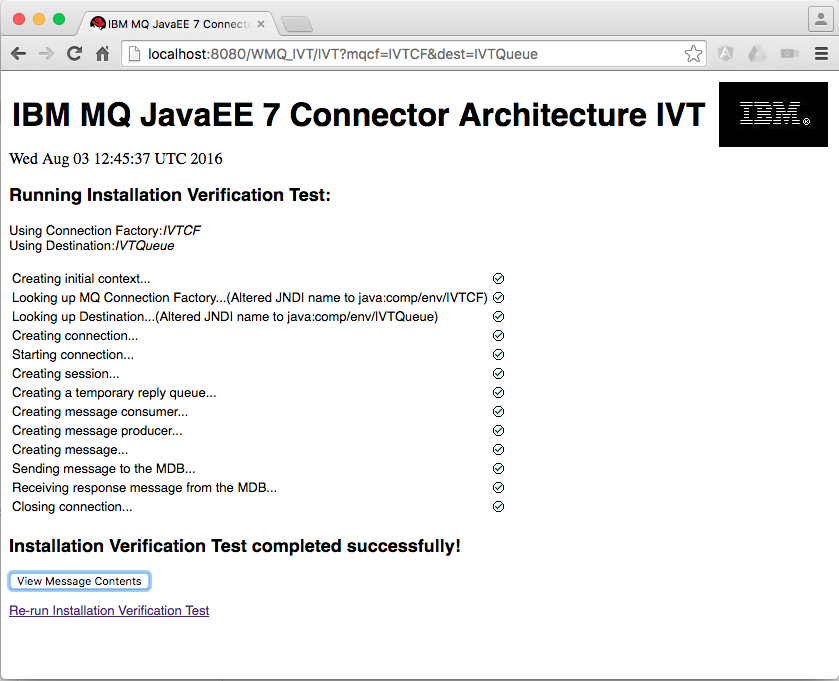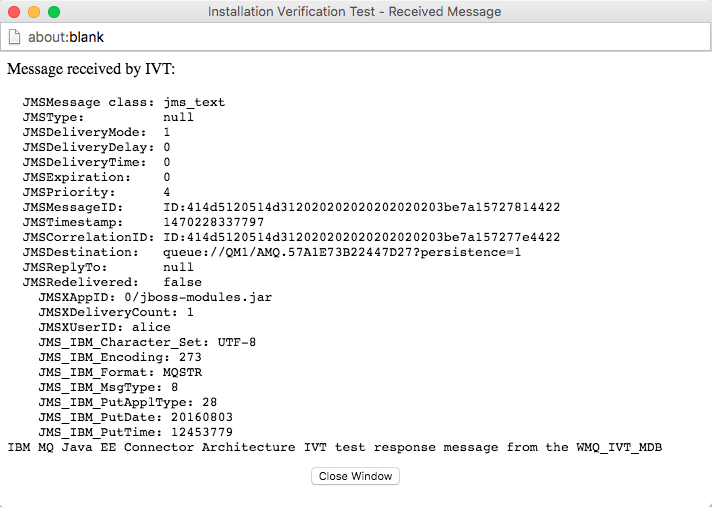Last year for a previous customer I wrote an article/post about WebsphereMQ Best Practice with JBoss EAP 6. Today we will make almost the same setup but with JBoss EAP 7, WebsphereMQ Sample IVT application, and both running on Docker. This tutorial demonstrates how to configure and connect these enterprise technologies in a containerized environment. I assume you have basic knowledge of Docker commands and concepts.
Howto run JBoss EAP 7 connected to WebsphereMQ both running on Docker
Prerequisites
For this lab, you need the following software:
- Package of JBoss EAP 7 http://www.jboss.org/products/eap/download/
- Docker for Linux, Mac, or Windows >= 1.12 installed on your system
Warning
Warning, this is for trial/demo purposes only. A production deployment requires the purchase of a subscription for JBoss and a license for IBM WebsphereMQ.
Clone git project
First of all, clone the git repository project that contains all the necessary configuration files.
git clone git@github.com:gautric/JBoss-WMQ.git
cd JBoss-WMQ
EAP 7 image creation
We need to download the JBoss EAP 7 binary and create the correct Docker image for EAP 7.
Copy the binary file to the JBoss-WMQ/jboss directory and navigate to this directory to build the image.
cd JBoss-WMQ
docker build -t jboss-ivt jboss
Here’s the Dockerfile for the JBoss EAP 7 image:
### Set the base image to Fedora
FROM jboss/base-jdk:8
## docker build -t jboss-ivt jboss
## docker run -p 8080:8080 -p 9990:9990 -t jboss-ivt
### File Author / Maintainer
MAINTAINER "Greg Autric" "gautric@redhat.com"
### Set Environment
ENV JBOSS_HOME /opt/jboss/jboss-eap-7.0
ENV MQM_HOME /opt/mqm
ENV MQM_URL http://public.dhe.ibm.com/ibmdl/export/pub/software/websphere/messaging/mqadv/mqadv_dev90_linux_x86-64.tar.gz
### Install EAP 7.0.0
COPY jboss-eap-7.0.0.zip /opt
RUN unzip /opt/jboss-eap-7.0.0.zip 1> /dev/null && echo "Install JBoss instance"
## Change user to install some
USER root
RUN cd /tmp && yum install -y wget && wget ${MQM_URL} && tar -zxvf ./*.tar.gz 1> /dev/null && cd MQServer && ./mqlicense.sh -text_only -accept && rpm -ivh MQSeriesJava*.rpm MQSeriesRuntime*.rpm
RUN rm -rf /tmp/*
### Create Admin EAP user
USER jboss
RUN $JBOSS_HOME/bin/add-user.sh admin admin123! --silent
## Copy EAR and RAR
RUN cp ${MQM_HOME}/java/lib/jca/wmq.jmsra.ivt.ear ${JBOSS_HOME}/standalone/deployments
RUN cp ${MQM_HOME}/java/lib/jca/wmq.jmsra.rar ${JBOSS_HOME}/standalone/deployments
### JBoss configuration files
COPY jboss-overlay.cli /opt
COPY jboss-ejb3.xml /opt
COPY jboss-web.xml /opt
### Configure EAP
RUN echo "JAVA_OPTS=\"\$JAVA_OPTS -Djboss.bind.address=0.0.0.0 -Djboss.bind.address.management=0.0.0.0\"" >> $JBOSS_HOME/bin/standalone.conf
RUN ${JBOSS_HOME}/bin/jboss-cli.sh --file=/opt/jboss-overlay.cli
RUN rm -rf ${JBOSS_HOME}/standalone/configuration/standalone_xml_history/current
RUN chown -R jboss:jboss ${JBOSS_HOME}
### Open Ports
EXPOSE 8080 9990
### Start EAP
CMD ${JBOSS_HOME}/bin/standalone.sh -c standalone-full.xml
Information about this image
- Admin User:
- An admin user is created with a predefined password for management access
- Application and RAR:
- The demo application and WMQ Resource Adapter come from the official WMQ tgz
- We download it, install only the Java RPM packages, and copy the rar and ear files to the correct JBoss deployment directory
- JBoss CLI:
- The CLI script consists of two specific parts:
- Resource Adapter configuration - setting system properties for the RAR (user/pass/channel/queueManager, etc.)
- Deployment overlay - used to adapt/provide correct configuration from JBoss to the application
- jboss-web.xml to adapt war configuration
- jboss-ejb3.xml for providing ejb configuration
- It runs in embed-server mode (offline) to configure the server during image build
- The CLI script consists of two specific parts:
Here’s the CLI file that configures JBoss EAP 7:
embed-server --server-config=standalone-full.xml
deployment-overlay add --name=jboss-ejb-overlay --content=/WMQ_IVT_MDB.jar/META-INF/jboss-ejb3.xml=/opt/jboss-ejb3.xml --deployments=wmq.jmsra.ivt.ear --redeploy-affected
deployment-overlay add --name=jboss-web-overlay --content=/WMQ_IVT.war/WEB-INF/jboss-web.xml=/opt/jboss-web.xml --deployments=wmq.jmsra.ivt.ear --redeploy-affected
# Remove unused stuff
/subsystem=datasources:remove
/subsystem=webservices:remove
/subsystem=jpa:remove
/subsystem=infinispan:remove
/subsystem=ejb3:write-attribute(name=default-resource-adapter-name, value=${ejb.resource-adapter-name:wmq.jmsra.rar})
/subsystem=resource-adapters/resource-adapter=wmq.jmsra.rar:add(archive=wmq.jmsra.rar,transaction-support=LocalTransaction,statistics-enabled=true)
/subsystem=resource-adapters/resource-adapter=wmq.jmsra.rar/connection-definitions=JMS2CF:add(class-name=com.ibm.mq.connector.outbound.ManagedConnectionFactoryImpl,jndi-name=JMS2CF, use-java-context=false)
/subsystem=resource-adapters/resource-adapter=wmq.jmsra.rar/connection-definitions=JMS2CF/config-properties=hostName:add(value=${websphere.hostName:localhost})
/subsystem=resource-adapters/resource-adapter=wmq.jmsra.rar/connection-definitions=JMS2CF/config-properties=password:add(value=${websphere.password:mqm})
/subsystem=resource-adapters/resource-adapter=wmq.jmsra.rar/connection-definitions=JMS2CF/config-properties=queueManager:add(value=${websphere.queueManager:QUEUE.MANAGER})
/subsystem=resource-adapters/resource-adapter=wmq.jmsra.rar/connection-definitions=JMS2CF/config-properties=port:add(value=${websphere.port:1414})
/subsystem=resource-adapters/resource-adapter=wmq.jmsra.rar/connection-definitions=JMS2CF/config-properties=channel:add(value=${websphere.channel:SYSTEM.AUTO.SVRCONN})
/subsystem=resource-adapters/resource-adapter=wmq.jmsra.rar/connection-definitions=JMS2CF/config-properties=transportType:add(value=${websphere.transportType:CLIENT})
/subsystem=resource-adapters/resource-adapter=wmq.jmsra.rar/connection-definitions=JMS2CF/config-properties=username:add(value=${websphere.username:mqm})
/subsystem=resource-adapters/resource-adapter=wmq.jmsra.rar/connection-definitions=IVTCF:add(class-name=com.ibm.mq.connector.outbound.ManagedConnectionFactoryImpl,jndi-name=jms/ivt/IVTCF, use-java-context=false)
/subsystem=resource-adapters/resource-adapter=wmq.jmsra.rar/connection-definitions=IVTCF/config-properties=hostName:add(value=${websphere.hostName:localhost})
/subsystem=resource-adapters/resource-adapter=wmq.jmsra.rar/connection-definitions=IVTCF/config-properties=password:add(value=${websphere.password:mqm})
/subsystem=resource-adapters/resource-adapter=wmq.jmsra.rar/connection-definitions=IVTCF/config-properties=queueManager:add(value=${websphere.queueManager:QUEUE.MANAGER})
/subsystem=resource-adapters/resource-adapter=wmq.jmsra.rar/connection-definitions=IVTCF/config-properties=port:add(value=${websphere.port:1414})
/subsystem=resource-adapters/resource-adapter=wmq.jmsra.rar/connection-definitions=IVTCF/config-properties=channel:add(value=${websphere.channel:SYSTEM.AUTO.SVRCONN})
/subsystem=resource-adapters/resource-adapter=wmq.jmsra.rar/connection-definitions=IVTCF/config-properties=transportType:add(value=${websphere.transportType:CLIENT})
/subsystem=resource-adapters/resource-adapter=wmq.jmsra.rar/connection-definitions=IVTCF/config-properties=username:add(value=${websphere.username:mqm})
/subsystem=resource-adapters/resource-adapter=wmq.jmsra.rar/admin-objects=QueuePool:add(class-name=com.ibm.mq.connector.outbound.MQQueueProxy,jndi-name=jms/ivt/IVTQueue,use-java-context=true,enabled=true)
/subsystem=resource-adapters/resource-adapter=wmq.jmsra.rar/admin-objects=QueuePool/config-properties=baseQueueName:add(value=${websphere.queueName:Q_QUEUE})
/subsystem=resource-adapters/resource-adapter=wmq.jmsra.rar/admin-objects=QueuePool/config-properties=baseQueueManagerName:add(value=${websphere.queueManager:QUEUE.MANAGER})
# Websphere MQ Host and Port
#/system-property=websphere.hostName:add(value=wmq-ivt)
#/system-property=websphere.port:add(value=1414)
# Websphere MQ configuration
/system-property=websphere.transportType:add(value=CLIENT)
/system-property=websphere.username:add(value=alice)
/system-property=websphere.password:add(value=passw0rd)
/system-property=websphere.channel:add(value=PASSWORD.SVRCONN)
/system-property=websphere.queueManager:add(value=QM1)
/system-property=websphere.queueName:add(value=Q_QUEUE)
/system-property=websphere.resource.adapter:add(value=wmq.jmsra.rar)
/system-property=ejb.resource-adapter-name:add(value=wmq.jmsra.rar)
reload --admin-only=false
WMQ image creation
Now we’ll create the WebsphereMQ Docker image. We’ll reuse a public image to build our own version with custom configurations. Navigate back to our git repository root to build our custom image:
cd JBoss-WMQ
docker build -t wmq-ivt wmq
Here’s the Dockerfile for the WebsphereMQ image:
FROM ibmcom/mq
RUN useradd alice -G mqm && \
echo alice:passw0rd | chpasswd
COPY config.mqsc /etc/mqm/
We use a minimal configuration for WebsphereMQ. The alice account is created with permissions to connect to WebsphereMQ, and we also create a simple queue for our application.
Here’s the WebsphereMQ configuration file:
DEFINE CHANNEL(PASSWORD.SVRCONN) CHLTYPE(SVRCONN)
SET CHLAUTH(PASSWORD.SVRCONN) TYPE(BLOCKUSER) USERLIST('nobody') DESCR('Allow privileged users on this channel')
SET CHLAUTH('*') TYPE(ADDRESSMAP) ADDRESS('*') USERSRC(NOACCESS) DESCR('BackStop rule')
SET CHLAUTH(PASSWORD.SVRCONN) TYPE(ADDRESSMAP) ADDRESS('*') USERSRC(CHANNEL) CHCKCLNT(REQUIRED)
ALTER AUTHINFO(SYSTEM.DEFAULT.AUTHINFO.IDPWOS) AUTHTYPE(IDPWOS) ADOPTCTX(YES)
DEFINE QL(Q_QUEUE)
REFRESH SECURITY TYPE(CONNAUTH)
Docker compose to run demo
Finally, we use Docker Compose to run both containers (JBoss and WebsphereMQ) together. We set up environment variables for flexible configuration, such as the WebsphereMQ hostname and port.
version: '2'
services:
jboss-ivt:
image: jboss-ivt
build: jboss
ports:
- "8080:8080"
- "9990:9990"
environment:
JAVA_OPTS: "-Dwebsphere.hostName=wmq-ivt -Dwebsphere.port=1414"
links:
- wmq-ivt
depends_on:
- wmq-ivt
wmq-ivt:
image: wmq-ivt
build: wmq
environment:
LICENSE: "accept"
MQ_QMGR_NAME: "QM1"
ports:
- "1414:1414"
Run it and check it
Use docker-compose to start both the WebsphereMQ and JBoss EAP 7 containers:
docker-compose up
Once both containers are running, navigate to IVT URL http://localhost:8080/WMQ_IVT/IVT in your browser to see the web application.
Web result
The Application page

The Result page

The JMS inspection (View Message Contents) page

Console output
When you run the containers, you should see output similar to this (truncated for brevity):
[mbp:~/Source/git/JBoss-WMQ]$> docker-compose up
Starting jbosswmq_wmq-ivt_1
Starting jbosswmq_jboss-ivt_1
Attaching to jbosswmq_wmq-ivt_1, jbosswmq_jboss-ivt_1
wmq-ivt_1 | ----------------------------------------
wmq-ivt_1 | Name: IBM MQ
wmq-ivt_1 | Version: 9.0.0.0
wmq-ivt_1 | Level: p900-L160520.DE
wmq-ivt_1 | BuildType: IKAP - (Production)
wmq-ivt_1 | Platform: IBM MQ for Linux (x86-64 platform)
wmq-ivt_1 | Mode: 64-bit
wmq-ivt_1 | O/S: Linux 4.4.15-moby
wmq-ivt_1 | InstName: Installation1
wmq-ivt_1 | InstDesc:
wmq-ivt_1 | Primary: Yes
wmq-ivt_1 | InstPath: /opt/mqm
wmq-ivt_1 | DataPath: /var/mqm
wmq-ivt_1 | MaxCmdLevel: 900
wmq-ivt_1 | LicenseType: Developer
wmq-ivt_1 | ----------------------------------------
wmq-ivt_1 | IBM MQ queue manager 'QM1' starting.
wmq-ivt_1 | The queue manager is associated with installation 'Installation1'.
wmq-ivt_1 | 5 log records accessed on queue manager 'QM1' during the log replay phase.
wmq-ivt_1 | Log replay for queue manager 'QM1' complete.
wmq-ivt_1 | Transaction manager state recovered for queue manager 'QM1'.
wmq-ivt_1 | IBM MQ queue manager 'QM1' started using V9.0.0.0.
wmq-ivt_1 | ----------------------------------------
wmq-ivt_1 | QMNAME(QM1) STATUS(Running)
jboss-ivt_1 | JAVA_OPTS already set in environment; overriding default settings with values: -Dwebsphere.hostName=wmq-ivt -Dwebsphere.port=1414
jboss-ivt_1 | =========================================================================
jboss-ivt_1 |
jboss-ivt_1 | JBoss Bootstrap Environment
jboss-ivt_1 |
jboss-ivt_1 | JBOSS_HOME: /opt/jboss/jboss-eap-7.0
jboss-ivt_1 |
jboss-ivt_1 | JAVA: /usr/lib/jvm/java/bin/java
jboss-ivt_1 |
jboss-ivt_1 | JAVA_OPTS: -server -verbose:gc -Xloggc:"/opt/jboss/jboss-eap-7.0/standalone/log/gc.log" -XX:+PrintGCDetails -XX:+PrintGCDateStamps -XX:+UseGCLogFileRotation -XX:NumberOfGCLogFiles=5 -XX:GCLogFileSize=3M -XX:-TraceClassUnloading -Dwebsphere.hostName=wmq-ivt -Dwebsphere.port=1414 -Djboss.bind.address=0.0.0.0 -Djboss.bind.address.management=0.0.0.0
jboss-ivt_1 |
jboss-ivt_1 | =========================================================================
Conclusion
JBoss EAP 7 proves to be highly flexible for enterprise messaging integration. In this tutorial, I used the Deployment Overlay feature for the first time, which is extremely useful when you cannot modify the original ear or war packages. We also utilized the embed-server mode to configure the JBoss instance offline during the Docker build process.
I would like to thank the IBM Messaging team for providing the WMQ Docker hub image, which was instrumental in demonstrating the integration between JBoss EAP 7 and WebsphereMQ in a containerized environment.